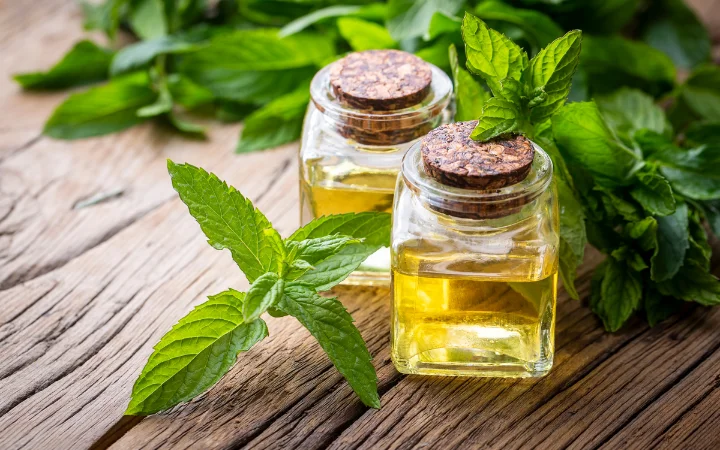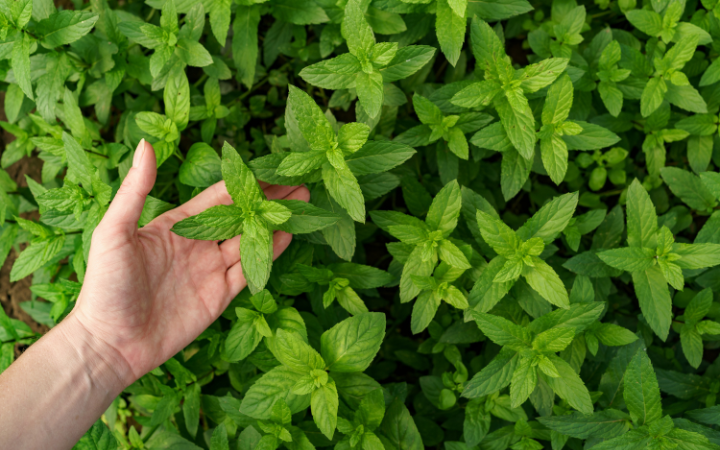Peppermint, with its invigorating scent and myriad of benefits, has woven its way into the fabric of both traditional and modern wellness practices. From the cooling touch it lends to a sunburnt skin to the refreshing zing it adds to your morning tea, peppermint is a testament to nature’s ability to nurture and heal. This article delves deep into the essence of peppermint, exploring its uses, benefits, and the science behind its potency. Whether you’re a long-time enthusiast or a curious newcomer, prepare to embark on a minty journey that promises to enlighten and invigorate.
Introduction to Peppermint
What is Peppermint?
Peppermint, a hybrid mint stemming from watermint and spearmint, thrives in various parts of the world. Renowned for its cooling effect and refreshing aroma, this herb has transcended its culinary roots to become a staple in holistic health practices. The menthol content in peppermint is what gives it that characteristic cooling sensation, making it a favorite among essential oils.
Historical Use of Peppermint
The history of peppermint is as rich and layered as its flavor. Dating back to ancient civilizations, including the Egyptians, Greeks, and Romans, peppermint was revered not just for its aromatic qualities but also for its medicinal properties. It was commonly used to soothe stomach ailments, freshen breath, and even as a currency. Fast forward to today, and peppermint continues to be a versatile player in the realms of aromatherapy, digestive health, and beyond.
In this era, the applications of peppermint have expanded exponentially, touching on everything from pain management to mental health. Its antioxidant and anti-inflammatory properties have been validated by scientific research, cementing peppermint’s status as a natural remedy worth exploring. Discover the healing powers of peppermint, from a steaming cup of herbal tea to a revitalizing drop of essential oil in a diffuser.
As we delve deeper into the world of peppermint, it’s clear that this herb is more than just a flavor enhancer. It’s a testament to the synergy between nature and well-being, offering a holistic approach to health that is both timeless and timely. Stay tuned as we explore the multifaceted benefits and uses of peppermint, a true gift from nature’s bounty.
Peppermint Oil Benefits and Uses
A Versatile Essential Oil
Explore the powerhouse of benefits that peppermint oil offers, making it a standout in any essential oil collection. Its versatility spans from soothing inner body symptoms to enhancing beauty and household uses. Let’s dive into how this oil can make a significant difference in our lives.
Alleviating Inner Body Symptoms
- Pain Relief: Applying peppermint oil mixed with a carrier oil directly to sore muscles can work wonders. It relaxes muscles and eases tension, offering natural relief.
- Eases Sinus Pressure: Battling sinus congestion? Inhaling peppermint oil can clear up mucus and relieve inflammation, acting as a natural decongestant.
- Reduces Cravings: Struggling with diet cravings? A whiff of peppermint oil might just be the trick to curb those hunger pangs naturally.
Improving Mental and Physical Well-being
- Improves Focus and Promotes Energy: Feeling sluggish? The refreshing scent of peppermint oil can clear brain fog and boost energy without the need for caffeine.
- Fever Reduction: Peppermint oil, known for its cooling effect, can help bring down a fever when used alongside over-the-counter medications.
- Reduces Nausea: For those facing nausea, especially chemotherapy patients, peppermint oil has shown to be a potent remedy, outperforming some conventional medications.
Enhancing Beauty and Household Uses
- Improves Dandruff: Adding a few drops of peppermint oil to your shampoo can fight off dandruff and even help with lice infestations.
- Natural Insect Repellent: The strong scent of peppermint oil keeps ticks, mosquitoes, and moths at bay, offering a safe alternative to chemical repellents.
- Acne Treatment: Thanks to its anti-microbial properties, peppermint oil is effective against acne breakouts.
- Sunburn Relief: Peppermint oil can soothe sunburnt skin, promoting healing by keeping the skin clean and hydrated.
Peppermint oil, with its myriad of uses, proves to be an indispensable addition to our wellness toolkit. Whether it’s for health, beauty, or home, the benefits of peppermint oil are too significant to overlook.

As we continue to explore the wonders of peppermint, it’s clear that this natural remedy holds the key to a healthier, more vibrant life.
Cultivation and Extraction
Growing and Harvesting Peppermint
Learn how growing peppermint can be both rewarding and straightforward with these tips. This herb thrives in cool, moist conditions, preferring partial shade to full sun. For optimal growth, ensure the soil is rich and well-drained. Regular watering keeps the plant healthy, but be careful not to overwater. Harvesting peppermint before it flowers will yield the most potent leaves, rich in essential oils.
Cultivation Tips
Firstly, choose a spot that gets ample indirect light. Secondly, enrich the soil with organic matter to boost nutrient content. Lastly, space the plants about 18 to 24 inches apart to allow for ample growth.
Extraction of Peppermint Oil
The process of extracting peppermint oil involves steam distillation. After harvesting, the leaves undergo steam distillation. This method separates the oil from the plant material. The result is a highly concentrated peppermint essential oil, ready for various uses.

In conclusion, growing and extracting peppermint offers a satisfying way to tap into the natural benefits of this versatile plant. With some care and the right conditions, anyone can enjoy the rewards of peppermint cultivation. Moreover, the extraction process, though intricate, yields an essential oil packed with health benefits. As we delve deeper into the essence of peppermint, its cultivation and extraction emerge as key steps in harnessing its full potential.
Health Benefits and Scientific Research
Peppermint in Medicine and Health
Discover how peppermint has earned its reputation in the medical community through impressive health benefits backed by scientific research. From aiding digestion to relieving pain, the applications are vast and well-supported by research.
Digestive Health
Firstly, peppermint oil is a boon for digestive health. It soothes the gastrointestinal tract, easing symptoms of IBS and reducing bloating. Furthermore, studies have shown that it can relax the muscles of the GI system, helping to alleviate discomfort.
Respiratory Benefits
Additionally, peppermint acts as a natural decongestant. It clears the respiratory tract, making breathing easier for those with colds or allergies. Moreover, its antimicrobial properties can help fight infections that lead to respiratory issues.
Pain Management
Moreover, peppermint oil is effective in managing different types of pain. It’s particularly beneficial for headaches and muscle aches. Applying it topically can provide quick relief, as the menthol induces a cooling sensation that acts as a natural analgesic.
Mental Health and Cognitive Effects
Furthermore, peppermint has positive effects on mental health and cognition. It enhances focus and energy, making it a great aid for those needing a mental boost. Additionally, its aroma has been linked to reducing stress and improving mood.
In essence, peppermint offers a plethora of health benefits, backed by scientific research. Whether it’s for physical or mental well-being, incorporating peppermint into your routine can lead to significant improvements. As we continue to explore its uses, it’s clear that peppermint is more than just a flavor enhancer—it’s a powerful natural remedy.
Culinary Uses of Peppermint
Peppermint in the Kitchen
Explore how peppermint shines not only as a medicinal marvel but also in the culinary world, adding a unique twist to dishes and drinks. Its fresh, vibrant flavor adds a unique twist to both sweet and savory dishes, making it a favorite among chefs and home cooks alike.
Cooking with Peppermint
First off, peppermint can transform a simple dish into something extraordinary. For instance, adding it to salads brings a refreshing burst of flavor. Similarly, it pairs beautifully with chocolate, lending a cool, minty note to desserts. Moreover, peppermint can elevate the taste of lamb and other meats, providing a herby freshness that cuts through the richness.
Peppermint in Beverages
Additionally, peppermint plays a starring role in beverages. From the classic mint tea, known for its digestive benefits, to more inventive cocktails and mocktails, peppermint adds depth and refreshment. Furthermore, it’s a key ingredient in many holiday drinks, bringing festive cheer with its distinctive flavor.

In conclusion, peppermint’s versatility extends well beyond its health benefits, making it a staple in kitchens around the world. Whether you’re whipping up a batch of minty chocolate cookies or brewing a soothing cup of tea, peppermint is sure to add a touch of magic to your culinary creations. As we delve further into the wonders of peppermint, its role in enhancing our meals and drinks stands out as yet another reason to celebrate this incredible herb.
Safety and Precautions
Using Peppermint Safely
While enjoying the plethora of benefits peppermint offers, it’s crucial to use it wisely to avoid potential side effects, ensuring safe and effective use. Understanding the right ways to use peppermint, especially its oil, ensures you reap the benefits without any drawbacks.
Topical Application
Firstly, when applying peppermint oil to the skin, always dilute it with a carrier oil. This precaution prevents skin irritation. Additionally, it’s wise to perform a patch test before widespread use. This step helps identify any allergic reactions. Moreover, avoid applying peppermint oil to sensitive areas, such as near the eyes or on broken skin.
Ingestion and Internal Use
Furthermore, while peppermint tea is generally safe for consumption, ingesting peppermint oil requires caution. Only use therapeutic-grade oil intended for internal use, and even then, in very small amounts. Additionally, consult with a healthcare provider before ingesting peppermint oil, especially if you have a medical condition or are pregnant.
Interactions and Contraindications
Moreover, peppermint can interact with certain medications and health conditions. For instance, it may affect how the body processes some types of medications, leading to either decreased effectiveness or increased side effects. Therefore, if you’re on medication, discussing peppermint use with your doctor is crucial.
In essence, while peppermint is a valuable addition to both your wellness and culinary toolkit, using it responsibly is key. By adhering to safety guidelines and precautions, you can enjoy all the benefits peppermint has to offer without any concerns. As we wrap up our exploration of peppermint, its importance in natural wellness and culinary arts remains clear, provided we approach its use with care and informed knowledge.
FAQs
Frequently Asked Questions About Peppermint
Peppermint, with its wide range of uses and benefits, naturally raises questions among those looking to incorporate it into their lives. Here, we address some of the most common queries.
What are the main benefits of peppermint oil?
Peppermint oil is renowned for its ability to soothe digestive issues, relieve pain, improve mental focus, and provide respiratory relief. Its cooling effect, courtesy of the menthol content, also makes it a popular choice for reducing fever and easing muscle tension.
How can peppermint oil be used safely?
To use peppermint oil safely, always dilute it with a carrier oil for topical application. For ingestion, ensure the oil is of therapeutic grade and consume it in minimal amounts. Always consult a healthcare professional before adding it to your regimen, especially if you have existing health conditions or are taking medication.
Can peppermint help with digestion issues?
Yes, peppermint can significantly aid in digestion. It relaxes the muscles of the GI tract, reducing symptoms of IBS and other digestive discomforts. Peppermint tea is a gentle way to enjoy these benefits, while peppermint oil capsules are an option for more targeted relief.
Is peppermint oil effective for headaches?
Indeed, peppermint oil is effective for relieving headaches. Applying diluted peppermint oil to the temples and forehead can provide relief from tension headaches thanks to its cooling properties and ability to relax muscles.
In wrapping up our journey through the world of peppermint, it’s clear this herb and its oil are not just versatile but also packed with health benefits. Whether you’re reaching for a bottle of essential oil or adding fresh leaves to your tea, peppermint stands ready to enhance your well-being and culinary experiences. Remember, though, to heed the safety advice and enjoy peppermint to its fullest, responsibly.
Conclusion
Summarizing the Versatility and Benefits of Peppermint
Peppermint, a humble herb, has proven itself to be a powerhouse of benefits and uses. Its journey from ancient civilizations to modern-day wellness and culinary practices underscores its enduring appeal and versatility. Whether it’s the soothing relief it brings to digestive discomfort, the clarity it offers to a foggy mind, or the refreshing twist it adds to culinary creations, peppermint has cemented its place as a cherished natural remedy and flavor enhancer.
The exploration of peppermint’s cultivation and extraction processes reveals not just the simplicity behind growing this plant but also the complexity involved in harnessing its potent oils. This duality adds depth to our understanding and appreciation of peppermint, encouraging a hands-on approach to incorporating it into our lives.
Moreover, the discussion around safety and precautions serves as a vital reminder of the importance of responsible usage. It ensures that our interactions with peppermint, particularly in its concentrated oil form, remain beneficial and free from adverse effects.
As we conclude, the essence of peppermint—captured through its myriad of benefits, uses, and the sheer joy it brings into our lives—leaves a lasting impression. It’s a testament to nature’s generosity, offering us solutions, comfort, and pleasure in a single, fragrant package. Peppermint isn’t just a herb; it’s a bridge to a healthier, more vibrant life, inviting us to explore, experiment, and enjoy all that it has to offer.

Thank you for joining me on this minty exploration. May the refreshing essence of peppermint inspire and invigorate your journey towards wellness and culinary delight.
